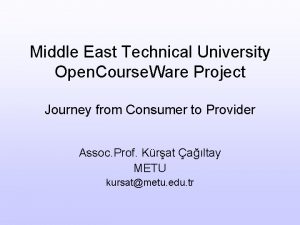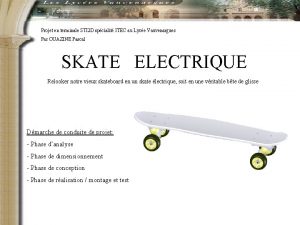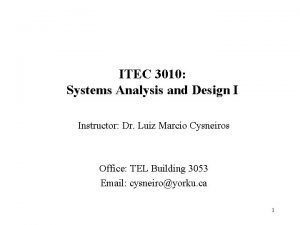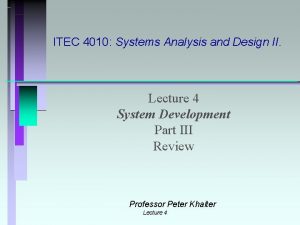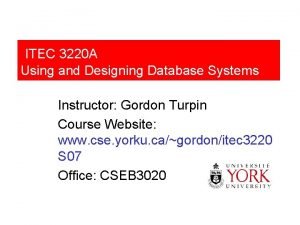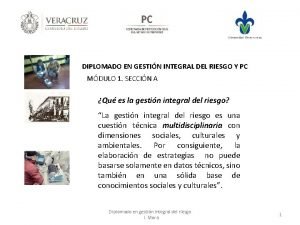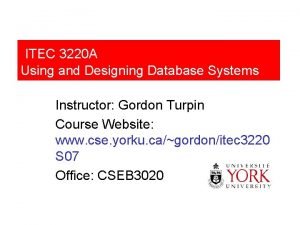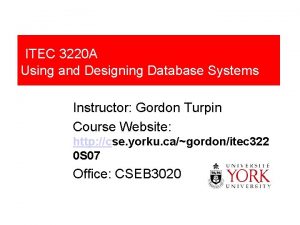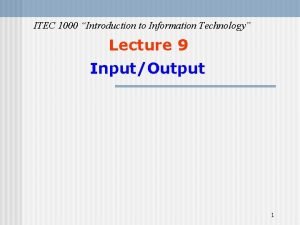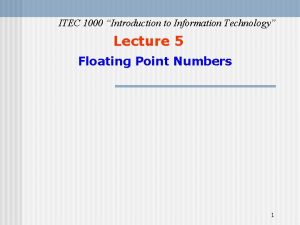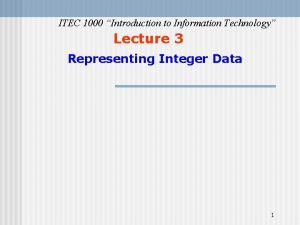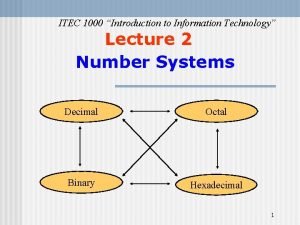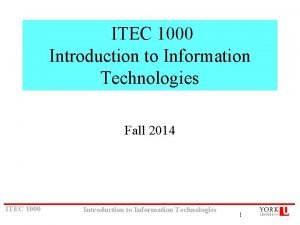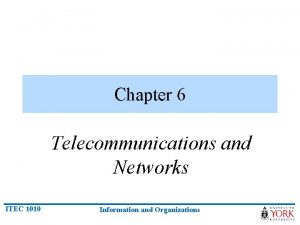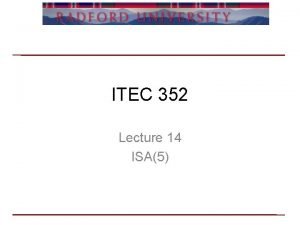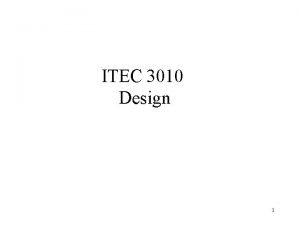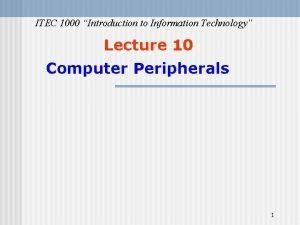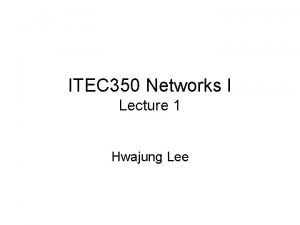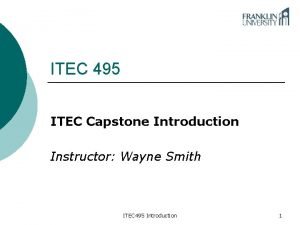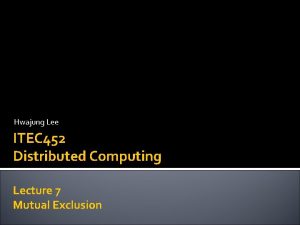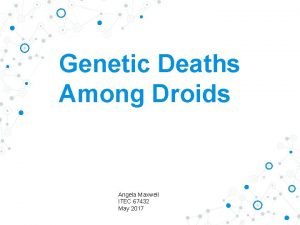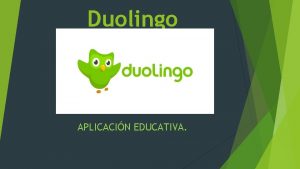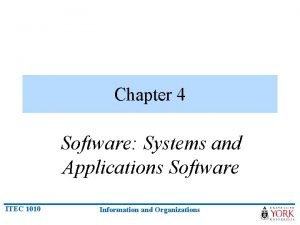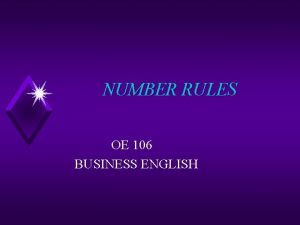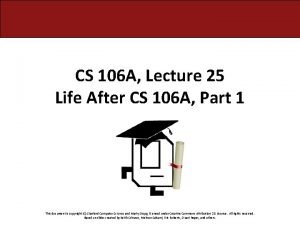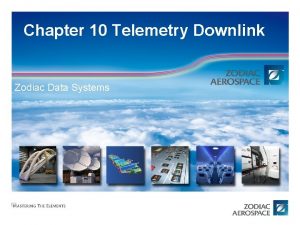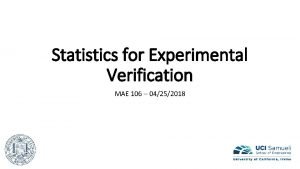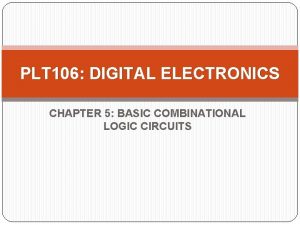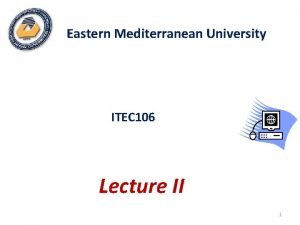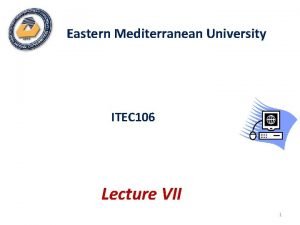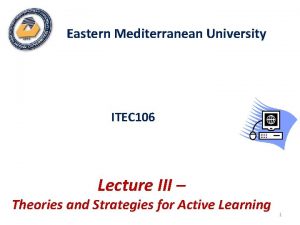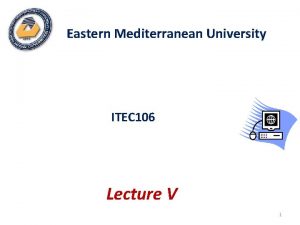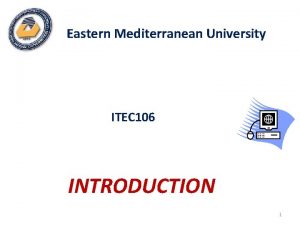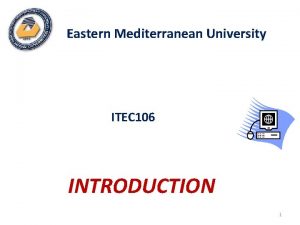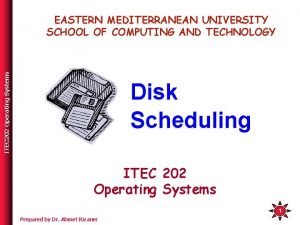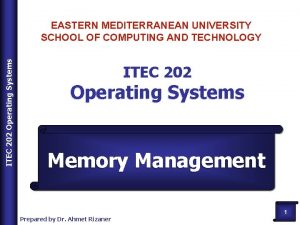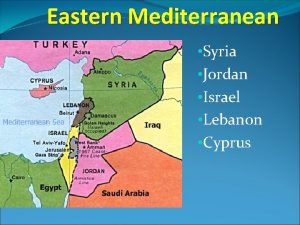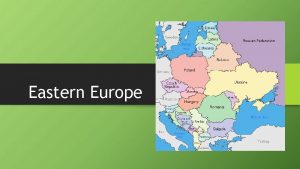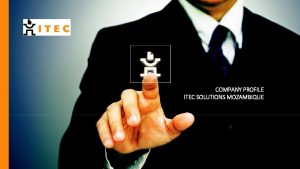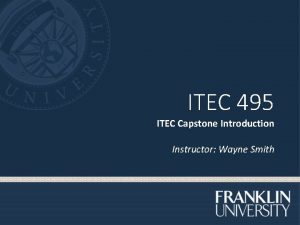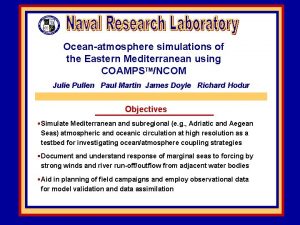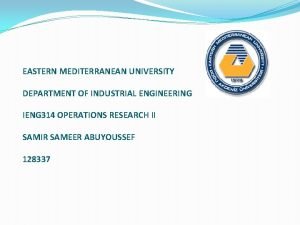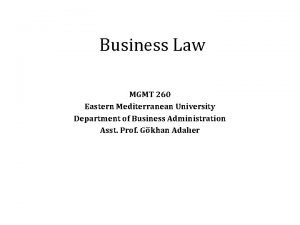Eastern Mediterranean University ITEC 106 Lecture VI Using




































- Slides: 36

Eastern Mediterranean University ITEC 106 Lecture VI

Using the Internet for Information Problem Solving

PROBLEM-BASED LEARNING FOR INFORMATION PROBLEM SOLVING • Problem-based learning is focused on solving a realistic problem in order to promote a deep understanding of a topic or a subject. • Such a problem is often unstructured and/or ambiguous and reflects real-world situations. • Students take an active role in solving the problem and thus develop problem-solving strategies while constructing knowledge about the problem. • Problem-based learning always begins with the curriculum; the real-world problem must be related to a curriculum topic. Dr. E. Iscioglu 3 CITE 350 - Internet Assisted Instruction

PROBLEM-BASED LEARNING FOR INFORMATION PROBLEM SOLVING. . . • Information problem-solving models describe the processes people use to solve problems; models can provide scaffolds to support students in locating and using information. • That structure permits learners to regulate their own learning processes. For example, the Big 6™ information problem-solving model. • Internet technologies provide excellent tools for developing information literacy skills. – For example, the Web can provide learning environments that simulate real-world situations and provide the context Dr. E. Iscioglu 4 for a problem. CITE 350 - Internet Assisted Instruction

PROBLEM-BASED LEARNING FOR INFORMATION PROBLEM SOLVING. . . • With problem-based learning, the teacher guides students through a problem-solving process. • Students can first apply the knowledge they already have, which helps them understand what information they need to acquire. • As students begin to research and acquire that information and contemplate possible solutions, they are developing the information literacy skills they need to become self-directed learners. • Problem-based learning can be considered a type of projectbased learning focused on a challenging problem or task that requires higher order thinking skills. Dr. E. Iscioglu 5 CITE 350 - Internet Assisted Instruction

PROBLEM-BASED LEARNING FOR INFORMATION PROBLEM SOLVING. . . • Usually a student working independently does not possess the knowledge, skills, or time to perform complex tasks or solve ambiguous problems. • Consequently, problem-based learning can help students learn to work together collaboratively and cooperatively. • Transfer of learning occurs when a learner applies knowledge or skills associated with one task to the completion of another task. • Basically, this is the goal of learning—to transfer knowledge and skills from one context to another. • Problem-based learning promotes transfer, and Web-enhanced learning can establish contexts that create opportunities for transfer to occur. Dr. E. Iscioglu CITE 350 - Internet Assisted Instruction 6

INFORMATION PROBLEMSOLVING MODELS • Problem solving is the process of designing and executing a series of steps to reach a goal. • There a number of problem-solving strategies, some of which are domain specific and some of which use general approaches. Dr. E. Iscioglu CITE 350 - Internet Assisted Instruction 7

Info. Savvy • One general problem-solving strategy is Info. Savvy by Ian Jukes (Jukes, Dosaj, & Macdonald, 2000), which considers a problem to be an information need and identifies five basic steps to solve that need: – – – 1. Asking 2. Accessing 3. Analyzing 4. Applying 5. Assessing • When these steps are applied to problem solving on the Internet, Jukes et al. call it Net. Savvy. • The Net. Savvy model helps students develop informationprocessing skills while completing relevant student projects and Dr. E. Iscioglu 8 using Internet technologies. CITE 350 - Internet Assisted Instruction

The Research Cycle • The Research Cycle by Jamie Mc. Kenzie (2000) differs from some other problem-solving models because its focus is on essential and subsidiary questions early in the problem-solving process. • The Research Cycle rejects the use of topical research because it puts students in the role of information consumers and demands little thought, imagination, or skill. Dr. E. Iscioglu CITE 350 - Internet Assisted Instruction 9

The Research Cycle. . . • In contrast, the Research Cycle puts students in the role of information producers and requires them to make up their own minds, create their own answers, and show independence and judgment. • Because students are actively revising and rethinking their research questions and plans throughout the process, they are forced to cycle back repeatedly through the steps or stages of the cycle. • Thus, the more skill they develop, the less linear the process. Dr. E. Iscioglu CITE 350 - Internet Assisted Instruction 10

The Research Cycle. . . • The Research Cycle is a recursive process: Students move repeatedly through each of the stepsquestioning, planning, gathering, sorting and sifting, synthesizing, and evaluating. • Reporting occurs after several repetitions of the cycle create sufficient insight on the part of students (Mc. Kenzie, 2000). Dr. E. Iscioglu CITE 350 - Internet Assisted Instruction 11

The Big 6 • The Big 6 model by Michael B. Eisenberg and Robert E. Berkowitz (1990) is a widely used, general problemsolving model that includes these steps: – – – task definition, information-seeking strategies, location and access, use of information, synthesis, and evaluation. Dr. E. Iscioglu CITE 350 - Internet Assisted Instruction 12

USING THE BIG 6 FOR WEB-ENHANCED LEARNING • The Big 6 is an information problem-solving process to guide students through the steps of solving a problem or making a decision. • The Big 6 model is comprised of six stages, each with two sub stages. • The six stages do not necessarily have to be completed in the recommended sequence, and some stages may be completed more than once during the problem-solving process. • The Big 6 model provides students with a structure for answering questions, completing assignments, and creating work products. • Many adaptations are available for use with multiple age groups or grade levels. Dr. E. Iscioglu CITE 350 - Internet Assisted Instruction 13

USING THE BIG 6 FOR WEB-ENHANCED LEARNING. . . The Big 6 Information Problem-Solving Model Dr. E. Iscioglu CITE 350 - Internet Assisted Instruction 14

Application of Big 6 Skills to Curriculum Areas Dr. E. Iscioglu CITE 350 - Internet Assisted Instruction 15

ENGAGING PARENTS WITH THE BIG 6 • Parents can play an important role in helping their children learn, but they need an effective approach. Mike Eisenberg and Bob Berkowitz (1996) explain how parents can incorporate the Big 6 skills into their support of their children’s homework assignments. • The Big 6 skills can be applied to any homework assignment that requires a solution or a result based on information. • Parents can assume the role of a coach, guiding their students through all the necessary steps to complete a school assignment. Dr. E. Iscioglu 16 CITE 350 - Internet Assisted Instruction

ENGAGING PARENTS WITH THE BIG 6 • Thus, parents can be useful partners in their children’s education by modeling the steps of a problem-solving strategy to guide their children through assignments and to help them become independent learners and users of information. • Teachers should be sure to share problem-solving strategies and models with parents and enlist their help applying these strategies at home as students complete classroom projects and homework assignments. Dr. E. Iscioglu CITE 350 - Internet Assisted Instruction 17

AUTHENTIC ASSESSMENT • Authentic assessment is an evaluation methodology that is intended to correspond to real-world experiences. • Its purpose is to provide an opportunity for students to produce an authentic performance. • Thus, authentic assessment is sometimes called performance assessment because it has long been used in training and apprenticeship programs in which assessment is based on the successful or appropriate performance of a task. • With performance assessment an instructor observes a student working on a real task, provides feedback, monitors the student’s application of the feedback, and adjusts instruction and evaluation accordingly. Authentic assessment applies the principles of performance assessment to the evaluation of realistic work products in all areas of the curriculum. Dr. E. Iscioglu 18 CITE 350 - Internet Assisted Instruction

AUTHENTIC ASSESSMENT. . . • The Pearson Education Development Group (2003) describes five types of authentic assessments: • 1. Performance assessment • 2. Short investigations • 3. Open-response questions • 4. Portfolios • 5. Self-assessment Dr. E. Iscioglu CITE 350 - Internet Assisted Instruction 19

AUTHENTIC ASSESSMENT. . . • A Comparison of Authentic and Traditional Methods of Assessment (Wiggins, 1990) Dr. E. Iscioglu CITE 350 - Internet Assisted Instruction 20

USING RUBRICS FOR ASSESSMENT • Rubrics are assessment tools that are useful for assessing criteria that are complex and subjective. • A rubric describes the various performance permutations of a task or activity in which students are engaged. • A rubric for a project would list the components the student should include to receive a certain score or rating. • Rubrics help students figure out how their projects will be evaluated and assist teachers in scoring or grading student performance. Dr. E. Iscioglu CITE 350 - Internet Assisted Instruction 21

USING RUBRICS FOR ASSESSMENT. . . • Effective assessment rubrics are essential for project-based learning and information problem-solving activities. • Whether general or task specific, a good rubric will provide accurate and appropriate information about students’skills. • The following procedure will help you create an authentic assessment rubric: § § § 1. Determine the essential learning objectives for the project. 2. Identify the criteria or standards of performance for each learning objective, and specify the evidence to be produced. 3. Develop a rubric matrix, and insert the criteria for product and process in the leftmost column. 4. Determine levels of competence or expertise, and enter labels for those levels in the topmost row. 5. Describe expected student performance for each of the criteria, and enter that information in the appropriate cell for each level. 6. Share the rubric with students before they begin the project. Dr. E. Iscioglu CITE 350 - Internet Assisted Instruction 22

Using the Internet for Cooperative Problem Solving

OVERVIEW • Web. Quests are a widely used teaching and learning tool to create cooperative problem solving activities. • Web. Quests are inquiry-oriented activities in which most or all of the information used by learners is acquired from the World Wide Web. • Web. Quests focus on using information to create knowledge. • Their educational rationale is to engage learners in real-world learning activities, develop critical-thinking skills, and support teamwork and cooperation. • The Web. Quest instructional model is comprised of several components: an introduction, a task, the process for accomplishing the task, the resources (usually Web-based) used to accomplish the task, an evaluation, and a conclusion. Dr. E. Iscioglu CITE 350 - Internet Assisted Instruction 24

A BRIEF HISTORY OF WEBQUESTS • Web. Quests are inquiry-oriented activities in which most or all of the information used by learners is acquired from the World Wide Web (Dodge, 1997). • Web. Quests focus on using information to create knowledge, rather than just looking for information; thus, they support the development of higher level thinking skills. • According to Tom March (1998), Web. Quests were designed to bring together the most effective instructional practices in one integrated student activity, maximizing student learning in a most efficient way. Dr. E. Iscioglu CITE 350 - Internet Assisted Instruction 25

A BRIEF HISTORY OF WEBQUESTS. . . • A Web. Quest is an interactive learning activity that uses a variety of Internet resources and guides students through a sequence of steps to organize their learning. • The Web. Quest model was developed in early 1995 at San Diego State University by Bernie Dodge with Tom March. Dodge, a professor of educational technology, developed the concept of Web. Quests while teaching a class for preservice teachers in the spring of 1995. Dr. E. Iscioglu 26 CITE 350 - Internet Assisted Instruction

EDUCATIONAL PRINCIPLES OF WEBQUESTS • Tom March (1998) explained the threefold rationale behind the instructional features of a Web. Quest: engaging learners in real-world learning activities, developing critical-thinking skills, and supporting teamwork and cooperation. – Real-world learning – Higher-order thinking – Teamwork Dr. E. Iscioglu CITE 350 - Internet Assisted Instruction 27

EDUCATIONAL PRINCIPLES OF WEBQUESTS. . . • Christie (2002) identified several of the same and several additional features of Web. Quests – Web. Quests encourage students to use reasoning skills in a problem-solving process that promotes deep understanding and meaningful learning. – Web. Quests require students to use critical-thinking skills to interpret, analyze, evaluate, and draw inferences from the information obtained. – Web. Quests use a collaborative process of discovery to facilitate learning. – Web. Quests promote the development of social skills, such as listening, cooperating, affirming others, giving constructive criticism, and accepting multiple perspectives. – Participation can also promote multiculturalism and appreciation of diversity. – Web. Quests facilitate reflection as students analyze and evaluate their own thinking and problem-solving processes. – Web. Quests foster interdisciplinary learning by making connections across content areas in the curriculum. Dr. E. Iscioglu CITE 350 - Internet Assisted Instruction 28

COOPERATIVE LEARNING • Cooperative learning is the instructional use of small groups to maximize individual and group learning (Johnson, & Holubec, 1990). • It is a set of processes that help people interact to accomplish a specific goal or end product. • Compared to collaborative learning, cooperative learning entails more structure and teacher direction and is more appropriate with well-defined, wellstructured problems. • Web. Quests are generally conducted with cooperative learning groups. Dr. E. Iscioglu 29 CITE 350 - Internet Assisted Instruction

WEBQUEST COMPONENTS. . . Elements of Cooperative Learning Groups (Johnson & Johnson, 1999) Dr. E. Iscioglu CITE 350 - Internet Assisted Instruction 30

WEBQUEST COMPONENTS • The Web. Quest site defines a Web. Quest as a “constructivist lesson format used widely around the world”. • Bernie Dodge (1997) called the Web. Quest model a lesson with several components, or building blocks, which can be reconfigured in many ways to accomplish a broad range of learning goals. • As was mentioned earlier, the original Web. Quest model had six components: an introduction, a task, the process for accomplishing the task, the resources (usually Web-based) to accomplish the task, an evaluation, and a conclusion. Dr. E. Iscioglu CITE 350 - Internet Assisted Instruction 31

WEBQUEST COMPONENTS. . . • The current Web. Quest model combines process and resources into a single component and is usually organized as a Web page with multiple sections or as a set of linked Web pages. – – – Introduction. The task. The process. Evaluation. Conclusion. Credits and references. Dr. E. Iscioglu CITE 350 - Internet Assisted Instruction 32

A PROCESS FOR ADAPTING AND ENHANCING WEBQUESTS • Before trying to create a new Web. Quest for a particular lesson, you should search through the thousands of Web. Quests already available on the World Wide Web to see whether any existing ones are appropriate for your purposes. • When searching for existing Web. Quests for your classroom use, remember that a Web page or a website that calls itself a Web. Quest may not have been created with Web. Quest design principles. • For that reason, the Web. Quest site recommends a process for adapting existing Web. Quests to your particular curriculum priorities and learning goals. Dr. E. Iscioglu CITE 350 - Internet Assisted Instruction 33

A Process for Adapting or Enhancing Web. Quests • Step 1: Choose a standard or topic • Step 2: Search for existing Web. Quests • Step 3: Determine whether a Web. Quest can be used as presented • Step 4: Select high-quality Web. Quests • Step 5: Identify changes to the Web. Quest • Step 6: Get author permission • Step 7: Download the Web. Quest • Step 8: Modify and enhance • Step 9: Evaluate and revise as needed • Step 10: Publish and share Dr. E. Iscioglu CITE 350 - Internet Assisted Instruction 34

Lesson Plan Template for Web. Quest Projects Dr. E. Iscioglu CITE 350 - Internet Assisted Instruction 35

Lesson Plan Template for Web. Quest Projects. . . Dr. E. Iscioglu CITE 350 - Internet Assisted Instruction 36
 Chapter 16 eastern mediterranean answers
Chapter 16 eastern mediterranean answers 01:640:244 lecture notes - lecture 15: plat, idah, farad
01:640:244 lecture notes - lecture 15: plat, idah, farad Eastern kentucky university aviation
Eastern kentucky university aviation University of eastern colorado firewatch
University of eastern colorado firewatch Metu open course
Metu open course Projet itec
Projet itec Ad systems exam slide
Ad systems exam slide Itec 4010
Itec 4010 Itec 3220
Itec 3220 Gestin itec
Gestin itec Itec 3220
Itec 3220 Itec 3220
Itec 3220 Itec 1000
Itec 1000 Itec 1000
Itec 1000 Itec 1000
Itec 1000 Itec 1000
Itec 1000 Itec 1000
Itec 1000 Itec 1010
Itec 1010 Itec exam results
Itec exam results First cut design class diagram
First cut design class diagram Dot pitch
Dot pitch Itec irrigation controller
Itec irrigation controller Itec 350
Itec 350 Itec
Itec Itec
Itec Cs itec
Cs itec Itec
Itec Edmodo founders
Edmodo founders Duolingo fecha de lanzamiento
Duolingo fecha de lanzamiento Itec software
Itec software 106 spelled out
106 spelled out Fahrenheit 451 coloring by number answer key
Fahrenheit 451 coloring by number answer key Cs
Cs Irig 106 chapter 10 sample data
Irig 106 chapter 10 sample data Mae 106 uci
Mae 106 uci Plt 106
Plt 106 106 pal
106 pal




